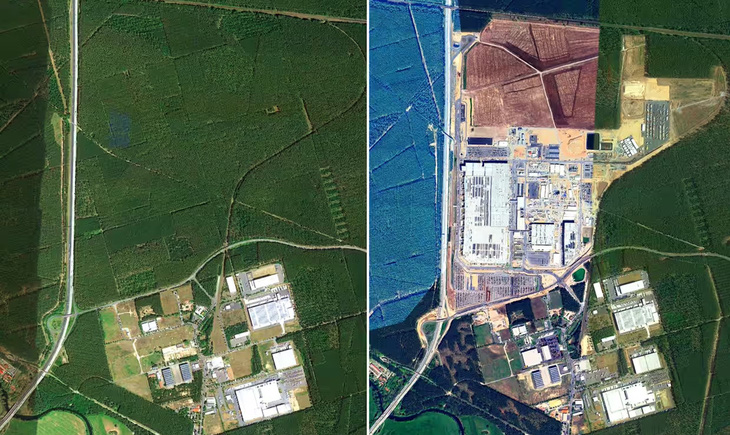Billionaire Elon Musk’s decision to cut down about half a million trees to build a Tesla factory in Germany has sparked a wave of harsh criticism from environmental activists.
Satellite images taken in 2019 and 2023 at the Tesla factory area in Brandenburg state show that green areas have been leveled to build the factory
According to an analysis of satellite images by environmental intelligence firm Kayrros, Tesla has leveled about 329 hectares of local forest, equivalent to 500,000 trees, between March 2020 and May 2023 during the construction of a giant electric car factory in the state of Brandenburg, near the capital Berlin, Germany.
Construction began in 2020 and the Tesla factory in Germany has a production capacity of up to 500,000 electric vehicles per year. This is Tesla’s only “gigafactory” – a factory of enormous scale – in Europe.
The project immediately faced fierce opposition from environmental groups, who accused Elon Musk ‘s gigafactory of polluting water sources and destroying wildlife habitat.
Since May 2024, environmental activists have criticized the plant’s expansion plans and attempted to storm the site.
Not only that, dozens of protesters have gathered outside the factory area to protest the project for months.

However, despite a series of criticisms, the Brandenburg State Ministry of Environment in July approved plans to expand the Tesla factory, aiming to double production to 1 million vehicles/year.
In addition, some experts have given their own opinions about Tesla cutting down trees to build the factory.
According to Antoine Halff – a leading analyst at Kayrros, the construction of the Tesla factory in Germany has caused many trees to be cut down. However, he said that the issue needs to be considered based on specific circumstances, as well as put on the scale to compare with the benefits received from replacing internal combustion engines with electric vehicles .
Halff estimates that the trees cut down are equivalent to about 13,000 tons of CO₂, which is about the same as the annual emissions from 2,800 internal combustion engine cars in the US. And that’s just a fraction of the number of electric cars Tesla produces and sells each quarter.

“Everything has a trade-off, so you need to understand what you have to trade off,” Mr. Halff concluded.
Tesla has not yet responded to the incident.






